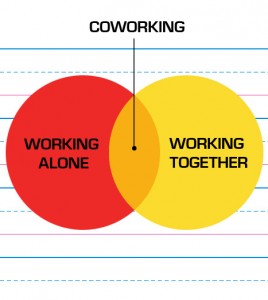By Finance New Mexico
 The dramatic increase in freelancers, especially technology industry soloists, is driving a new trend called “coworking” — the sharing of workspace on the basis of a desire for community that its proponents see as a basic human need.
The dramatic increase in freelancers, especially technology industry soloists, is driving a new trend called “coworking” — the sharing of workspace on the basis of a desire for community that its proponents see as a basic human need.
“Never before have we been so isolated,” Convivium Coworking’s Deborah Reese said of the growing army of solo entrepreneurs and self-employed people who populate the U.S. work force — either because the recession undermined their faith in working for others or because the internet and other mobile technology freed them to work anywhere they wanted.
Reese manages the 3,000-square-foot office space in Albuquerque, where people purchase memberships to occupy a desk or couch with all the amenities of the modern office. Those perks are nice, she said, but freelancers seek out coworking space largely for the camaraderie, increased productivity and creative inspiration of working around others.
New Manifestation of Age-Old Model
The core values of the coworking business model — including collaboration and community — are nothing new. Self-employed entrepreneurs, professionals and artisans for centuries have found ways to pool resources and complementary talents in mutually beneficial ways.
The modern business incubator shares some DNA with the coworking model, except that incubators breed separate resident businesses whose founders might share little more than office equipment and a quest for rapid growth. “It’s different than the incubator, because these are people trying to start a business they intend to [build],” Reese said. “What about people who don’t want to become the next Yahoo” and just want a social and collegial satellite to the home office?
Coworking’s closest cousins are the artists’ and artisans’ cooperatives and tech-oriented “hacker spaces,” where creative people coalesce to make something together or to share space, tools and ideas while working on their own projects.
Coworking, by contrast, starts from the ground up, Reese said. The space isn’t created until the community forms, and that’s done through organized gatherings at coffee shops or private homes. “You only buy or lease space if you have the community” to fill it, she said.
Growing Trend
Coworking is suited to today’s nomadic workers, many of whom work from home. Clients include consultants, contractors, web developers and even corporate telecommuters — people willing to spend between $150 and $300 per month for the opportunity to work where they can share expertise and tap into the expertise and creativity of others.
“Coworking spaces do exist in rural areas, but it takes members to make it work,” Reese said, and that can be challenging even in populous Albuquerque, where members might show up only for a few hours or a few days every week.
Despite these trials, coworking is catching on around the world, according to DeskMag, an electronic magazine dedicated to coworking. The United States accounts for about 850 of the 2,500 identified coworking spaces in 2013, and Albuquerque accounts for five bonafide coworking sites.
New Mexicans interested in starting a coworking space can start their research online at the Google Group dedicated to the phenomenon (https://groups.google.com/d/forum/coworking). A list of Albuquerque coworking sites is available at albuquerquecoworking.com and statewide resources are listed at Finance New Mexico.
Download 307_Coworkers by Choice_Shared Workspaces Draw Solo Entrepreneurs PDF
